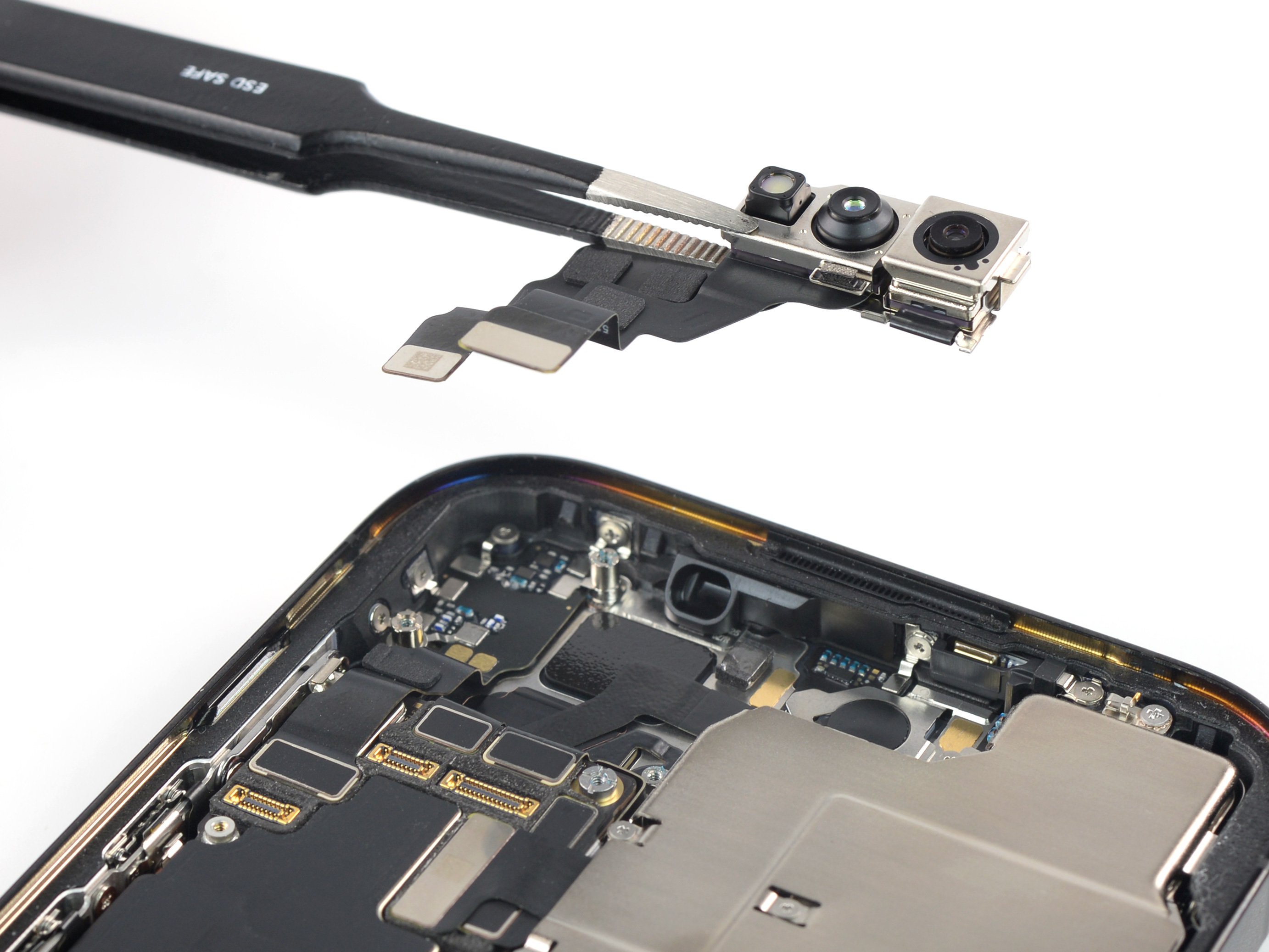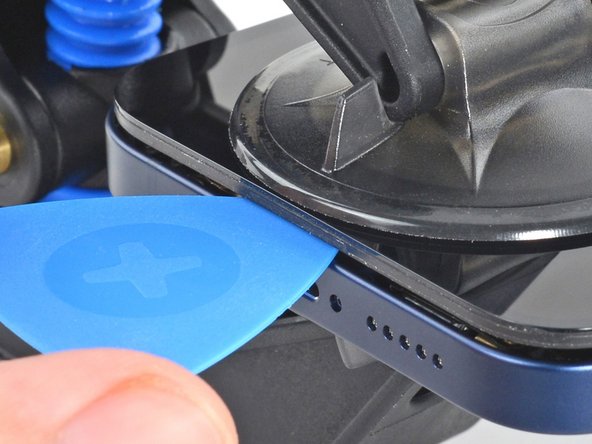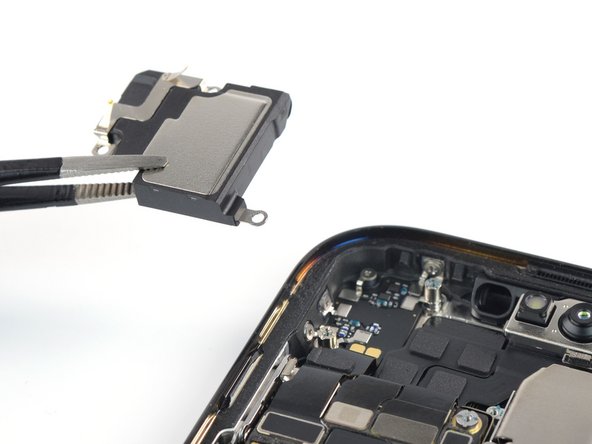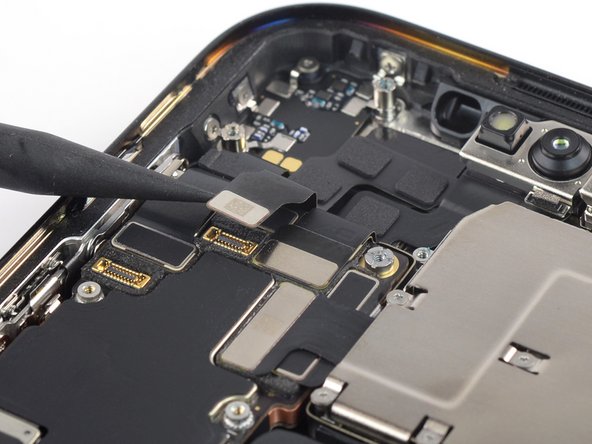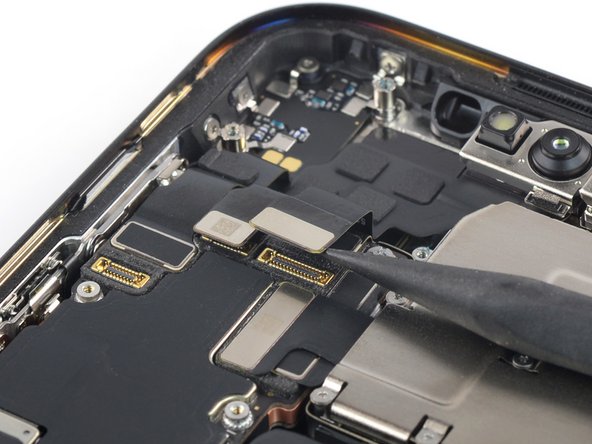iPhone 14 Pro Front-Facing Camera Assembly Replacement
Duration: 45 minutes
Steps: 27 Steps
Uh-oh! Looks like Face ID has decided to take a little vacation.
Ready to tackle the front-facing camera assembly replacement on your iPhone 14 Pro? You've come to the right place! This guide is crafted specifically for the A2890 (international) model, so if your iPhone 14 Pro is a bit different, don’t fret—everything should still work like a charm! This assembly brings together the front-facing camera and Face ID hardware into one neat package, and remember, those sensors are uniquely paired to your logic board. Just a heads up: if you swap this part out, Face ID might take a little vacation. While this repair will get your selfie cam back in action, keep in mind that on iOS 17.6 and earlier, only Apple or a certified technician can bring Face ID back to life. But on iOS 18 and newer, you can recalibrate new, genuine front-facing cameras using Apple's Repair Assistant. Before you dive in, grab some replacement adhesive to snugly secure the screen during reassembly. And don’t forget, maintaining water resistance after the repair hinges on how well you apply that screen adhesive. Just know that your device will lose its official IP (Ingress Protection) rating, so handle with care!
Step 1
- First things first, power off your iPhone. Safety first, right?
- Next, grab your screwdriver and remove the two 6.8 mm pentalobe P2 screws from the bottom edge of your iPhone. Easy peasy!
Step 2
Be careful not to push your opening pick in too far – it could end up causing damage to your device. To keep everything safe, mark your pick to avoid any mishaps.
You can also mark the other corners of the pick with different measurements to make it extra precise.
Or, if you’re feeling a bit creative, tape a coin about 3mm from the tip of the pick. It’s a neat trick to help keep things in check.
- Take a moment to measure 3 mm from the tip and give your opening pick a little mark with a permanent marker. You're doing great!
Step 3
Throw on those safety glasses—let’s keep your eyes safe from any rogue glass making a break for it during the repair.
Got a cracked iPhone screen? Keep those shards in check and avoid any accidental ouchies by carefully taping over the glass before you start your repair.
If the suction cup isn’t sticking, no worries—just give it a little extra bond by supergluing it to the screen.
- Grab some clear packing tape and lay those strips down overlapping each other until your iPhone's screen is completely covered. You got this!
- Having trouble getting that suction cup to stick? No worries! Just fold a sturdy piece of tape, like duct tape, into a handy handle and use that to lift the screen instead.
Tools Used
Step 4
In the next few steps, we're going to introduce you to the Anti-Clamp, our nifty little tool that makes opening up your device a breeze! If you don't have the Anti-Clamp handy, no worries—just skip ahead three steps for an alternative method.
Want to know how to use the Anti-Clamp like a pro? Check out this guide.
Is your iPhone's surface feeling a bit too slick for the Anti-Clamp to grip? No problem! Just slap on some tape to create a surface that's ready to hold on tight.
- Give that blue handle a gentle pull backwards—this unlocks the Anti-Clamp’s arms.
- Slide those arms over either the left or right edge of your iPhone. No need to be shy!
- Line up the suction cups close to the bottom edge of your iPhone—one goes on the front, one on the back.
- Squeeze the cups together to get a good grip on your phone. Suction powers, activate!
Step 5
- Slide the blue handle forward to lock those arms in place.
- Give the handle a full 360-degree clockwise twist, or keep turning until the suction cups start to stretch a bit.
- Keep an eye on the suction cups—they should stay nicely aligned. If they start to drift apart, just loosen them a little and realign the arms.
Step 6
Take it easy and only twist no more than a quarter turn at a time. Give it a minute between turns to let the Anti-Clamp and time work their magic for you!
For a full walkthrough on how to handle a hair dryer like a pro, give this guide a look.
If the Anti-Clamp isn’t opening up enough, heat the spot a bit more and twist the handle a quarter turn to get things moving.
- Give your iPhone a cozy spot on a sturdy surface, like a hardcover book, so it can chill hands-free and lie flat. This makes the next steps a breeze!
- Warm things up a bit by running a hair dryer along the bottom edge of your iPhone. It should feel just a tad too hot for comfort.
- Hang tight for a minute to let that adhesive loosen up and create a little gap for us.
- When the Anti-Clamp has done its magic and opened up a nice gap, slide an opening pick under the screen's plastic bezel.
- Feel free to skip the next couple of steps.
Tools Used
Step 7
Keep your hair dryer moving—don’t let it hang out in one spot too long!
Got a suction handle? Awesome! Next up, we'll use it to gently loosen the screen.
- Grab a hair dryer or heat gun and warm up the bottom edge of your iPhone for about 90 seconds, or until it feels just a tad too toasty to keep your fingers on comfortably.
Tools Used
Step 8
The screen’s watertight adhesive is seriously tough; popping open that first little gap takes some solid effort. If it’s being stubborn, try heating it up a bit more and gently rock the screen back and forth to soften the glue until you can slip your tool in.
- Place the suction cup gently on the bottom edge of the screen, but make sure you're not too close to the glass edge—give it some space!
- Now, pull up with steady, firm pressure on the suction cup to create just enough of a gap between the screen and its frame. It’s all about a little wiggle room.
- Slip an opening pick into that gap under the plastic bezel and let it do its thing. You’re almost there!
Tools Used
Step 9
- Grab your trusty hair dryer and give the right edge of your iPhone (that's the side with the power button) a warm hug for about 90 seconds or until it’s just a tad too hot to touch. You want to make it cozy for the next step!
Tools Used
Step 10
Keep your pick shallow—no more than 3 mm—so you don't poke any sensitive bits inside.
- Glide your opening pick along the bottom right corner of your iPhone—think of it as slicing through a stubborn sandwich. The adhesive doesn't stand a chance.
- Keep cruising up the right edge with your pick until you hit the top right corner. Smooth moves all the way.
- Let your pick hang out in that top right corner for now. It's earned a break before the next part.
Step 11
- Grab your hair dryer and warm up the top edge of your iPhone for about 90 seconds. You’re aiming for the screen to feel just a bit too warm to touch—like a cozy mug of cocoa, but for your phone.
Tools Used
Step 12
Keep your pick under 3 mm deep to avoid messing with the top sensors. We want to fix, not break!
- Gently slide the opening pick around the top right corner of your iPhone to loosen the adhesive up there.
- Keep the pick resting in the top left corner before moving on to the next step.
Step 13
- Grab your hair dryer and give the left edge of your iPhone a warm blast for about 90 seconds, or until it’s just a little too hot to touch. This helps loosen things up for the next steps!
Tools Used
Step 14
Heads up! The left edge of your iPhone is home to some fragile cables. Keep your pick away from this area to avoid any cable casualties.
Step 15
Heads up: the cables hugging the left edge are a bit sensitive, and a pick can easily mess them up. Try this alternate method to separate the left adhesive and keep things smooth.
Start applying the twist slowly—no rush here, just a smooth move.
If that sticky adhesive is giving you a hard time, give the left edge another little heat-up.
- Pop a second opening pick into the bottom left corner of your iPhone.
- Gently twist both picks together until the left edge releases from its clip.
Step 16
No handy surface to prop the screen on? No worries—your suction handle doubles as a nifty little stand!
- Gently peel your suction handle off the screen.
- Turn your iPhone so the right side is facing you.
- Open up your iPhone by swinging the screen up from the right, just like flipping open a book.
- Prop the screen up against something sturdy so it stays put while you work.
- When putting it back together, position the screen carefully, line up the clips along the top edge, and press the top edge down first before snapping the rest of the screen into place. If it doesn’t snap easily, double-check the clips around the screen to make sure none are bent or out of place.
Tools Used
Step 17
As you work through the repair, keep an eye on each screw and make sure it goes right back where it belongs. We don’t want any loose ends causing problems later on. Stay organized and your iPhone will be good as new in no time!
- Grab your Y000 screwdriver and unscrew the eight little guardians holding down the battery connector cover:
- When you’re putting things back together, this is your moment to check that your iPhone wakes up and everything is running smoothly—before locking the screen down for good. Just remember to shut it off again before you keep tinkering.
- Five screws, each 1.3 mm long
- Two screws, each 1.6 mm long
- One screw, 1.9 mm long
Step 18
- Grab the connector cover with some tweezers and gently slide it down to free up those flex cables.
- Now, go ahead and remove the connector cover.
Tools Used
Step 19
Be careful not to mess up the black silicone seal around this and other board connections. These little guys are like superheroes, keeping water and dust at bay to protect your device.
- Grab the pointed end of your trusty spudger and gently pry the battery cable connector straight up from its socket. No need to rush, take it slow.
- Once it's disconnected, give the connector a little bend away from the logic board. This prevents it from accidentally touching the socket and powering up your phone while you're in repair mode.
Tools Used
Step 20
- Grab your trusty spudger and use its pointed end to gently pry up the first display cable from its socket. Easy peasy!
- When it's time to re-attach connectors like this one, take your time! Align it carefully and press down on one side until you hear that satisfying click. Then, do the same on the other side—just avoid pressing down in the middle. If it's not aligned just right, those pins can bend, and we definitely don't want any permanent damage.
Tools Used
Step 21
- Grab your trusty spudger and use the pointed end to gently lift the second display cable connector straight up from its socket. You're doing great!
Tools Used
Step 22
- First things first, let’s get that screen off! Time to unveil the magic inside.
- Next up, grab your trusty isopropyl alcohol (90% or more) and give those areas a good clean. Once that’s done, apply some fresh adhesive where it’s needed!
- Now, before you dive back into putting everything together, take a moment here if you want to swap out the screen adhesives. It's a great time for a little upgrade!
Step 23
- Grab your trusty Phillips screwdriver and gently unscrew those two 1.6 mm-long screws that are holding the earpiece speaker in place. You're almost there!
Step 24
- Slip the pointy end of your spudger under the right side of the earpiece speaker—gentle ninja moves only.
- Give it a little lift with the spudger to loosen up the speaker. No need to muscle it, just a friendly nudge.
- Heads-up: there's a rubber gasket chilling on the top right edge of the speaker. When putting things back together, make sure it cozies up perfectly into its spot in the frame.
Tools Used
Step 25
- Grab a pair of tweezers or just your fingers and gently lift out the earpiece speaker.
Tools Used
Step 26
- Grab your trusty spudger and gently pry the camera and sensor cables straight up from their sockets to disconnect them. Easy does it!
Tools Used
Step 27
- Before sealing everything up with that fresh new adhesive, give your device a quick power-up and test it. Make sure it's working like a charm first.
- Double-check your new part against the original. Sometimes you’ll need to swap over some bits or peel off a few sticky backs before it fits perfectly.
- Putting your device back together? Just follow the steps backward, and you'll be all set.
- If your replacement part needs it, you can calibrate it using Apple's Repair Assistant (now available on iOS 18). Update your device, head to Settings→General→About→Parts & Service History, tap Restart & Finish Repair, and follow the prompts.
- Got e-waste? Be sure to take it to a certified recycler like R2 or e-Stewards to keep things green.
- Repair didn’t go as planned? No worries—try a little troubleshooting, or pop over to our Answers community for extra help. And hey, if you're really stuck, feel free to schedule a repair.
